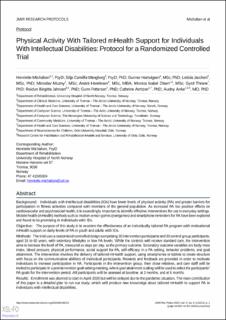| dc.contributor.author | Michalsen, Henriette | |
| dc.contributor.author | Wangberg, Silje C | |
| dc.contributor.author | Hartvigsen, Gunnar | |
| dc.contributor.author | Jaccheri, Maria Letizia | |
| dc.contributor.author | Muzny, Miroslav | |
| dc.contributor.author | Henriksen, André | |
| dc.contributor.author | Olsen, Monica Isabel Benedikte | |
| dc.contributor.author | Thrane, Gyrd | |
| dc.contributor.author | Jahnsen, Reidun Birgitta | |
| dc.contributor.author | Pettersen, Gunn | |
| dc.contributor.author | Arntzen, Cathrine | |
| dc.contributor.author | Anke, Audny | |
| dc.date.accessioned | 2020-09-10T08:09:25Z | |
| dc.date.available | 2020-09-10T08:09:25Z | |
| dc.date.created | 2020-06-10T23:02:13Z | |
| dc.date.issued | 2020 | |
| dc.identifier.citation | JMIR Research Protocols. 2020, 9 (6), | en_US |
| dc.identifier.issn | 1929-0748 | |
| dc.identifier.uri | https://hdl.handle.net/11250/2677167 | |
| dc.description.abstract | Background: Individuals with intellectual disabilities (IDs) have lower levels of physical activity (PA) and greater barriers for participation in fitness activities compared with members of the general population. As increased PA has positive effects on cardiovascular and psychosocial health, it is exceedingly important to identify effective interventions for use in everyday settings. Mobile health (mHealth) methods such as motion sensor games (exergames) and smartphone reminders for PA have been explored and found to be promising in individuals with IDs.
Objective: The purpose of this study is to examine the effectiveness of an individually tailored PA program with motivational mHealth support on daily levels of PA in youth and adults with IDs.
Methods: The trial uses a randomized controlled design comprising 30 intervention participants and 30 control group participants, aged 16 to 60 years, with sedentary lifestyles or low PA levels. While the controls will receive standard care, the intervention aims to increase the level of PA, measured as steps per day, as the primary outcome. Secondary outcome variables are body mass index, blood pressure, physical performance, social support for PA, self-efficacy in a PA setting, behavior problems, and goal attainment. The intervention involves the delivery of tailored mHealth support, using smartphones or tablets to create structure with focus on the communicative abilities of individual participants. Rewards and feedback are provided in order to motivate individuals to increase participation in PA. Participants in the intervention group, their close relatives, and care staff will be invited to participate in a preintervention goal-setting meeting, where goal attainment scaling will be used to select the participants’ PA goals for the intervention period. All participants will be assessed at baseline, at 3 months, and at 6 months.
Results: Enrollment was planned to start in April 2020 but will be delayed due to the pandemic situation. The main contribution of this paper is a detailed plan to run our study, which will produce new knowledge about tailored mHealth to support PA in individuals with intellectual disabilities.
Conclusions: We expect the new intervention to perform better than standard care in terms of improved PA, improved self-efficacy, and social support for activities. Technology offers new opportunities to promote healthy behaviors. The results of the study will determine the effectiveness and sustainability of a tailored mHealth support intervention to increase PA in youth and adults with IDs. | en_US |
| dc.language.iso | eng | en_US |
| dc.publisher | JMIR Publications | en_US |
| dc.rights | Navngivelse 4.0 Internasjonal | * |
| dc.rights.uri | http://creativecommons.org/licenses/by/4.0/deed.no | * |
| dc.title | Physical Activity With Tailored mHealth Support for Individuals With Intellectual Disabilities: Study Protocol for a Randomized Controlled Trial | en_US |
| dc.type | Peer reviewed | en_US |
| dc.type | Journal article | en_US |
| dc.description.version | publishedVersion | en_US |
| dc.source.volume | 9 | en_US |
| dc.source.journal | JMIR Research Protocols | en_US |
| dc.source.issue | 6 | en_US |
| dc.identifier.doi | 10.2196/19213 | |
| dc.identifier.cristin | 1814940 | |
| dc.description.localcode | ©Henriette Michalsen, Silje Camilla Wangberg, Gunnar Hartvigsen, Letizia Jaccheri, Miroslav Muzny, André Henriksen, Monica Isabel Olsen, Gyrd Thrane, Reidun Birgitta Jahnsen, Gunn Pettersen, Cathrine Arntzen, Audny Anke. Originally published in JMIR Research Protocols (http://www.researchprotocols.org), 29.06.2020. This is an open-access article distributed under the terms of the Creative Commons Attribution License (https://creativecommons.org/licenses/by/4.0/), which permits unrestricted use, distribution, and reproduction in any medium, provided the original work, first published in JMIR Research Protocols, is properly cited. The complete bibliographic information, a link to the original publication on http://www.researchprotocols.org, as well as this copyright and license information must be included. | en_US |
| cristin.ispublished | true | |
| cristin.fulltext | original | |
| cristin.qualitycode | 1 | |

